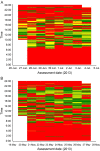Considerations when using the activPAL monitor in field-based research with adult populations
- PMID: 30356601
- PMCID: PMC6188993
- DOI: 10.1016/j.jshs.2016.02.002
Considerations when using the activPAL monitor in field-based research with adult populations
Abstract
Research indicates that high levels of sedentary behavior (sitting or lying with low energy expenditure) are adversely associated with health. A key factor in improving our understanding of the impact of sedentary behavior (and patterns of sedentary time accumulation) on health is the use of objective measurement tools that collect date and time-stamped activity information. One such tool is the activPAL monitor. This thigh-worn device uses accelerometer-derived information about thigh position to determine the start and end of each period spent sitting/lying, standing, and stepping, as well as stepping speed, step counts, and postural transitions. The activPAL is increasingly being used within field-based research for its ability to measure sitting/lying via posture. We summarise key issues to consider when using the activPAL in physical activity and sedentary behavior field-based research with adult populations. It is intended that the findings and discussion points be informative for researchers who are currently using activPAL monitors or are intending to use them. Pre-data collection decisions, monitor preparation and distribution, data collection considerations, and manual and automated data processing possibilities are presented using examples from current literature and experiences from 2 research groups from the UK and Australia.
Keywords: Inclinometer; Measurement; Physical activity; Posture; Sedentary behavior; Sitting.
Figures




References
-
- Tremblay M.S., Colley R.C., Saunders T.J., Healy G.N., Owen N. Physiological and health implications of a sedentary lifestyle. Appl Physiol Nutr Metab. 2010;35:725–740. - PubMed
-
- Sedentary Behavior Research Network Standardized use of the terms “sedentary” and “sedentary behaviors”. Appl Physiol Nutr Metab. 2012;37:540–542. - PubMed
-
- Owen N., Salmon J., Koohsari M.J., Turrell G., Giles-Corti B. Sedentary behavior and health: mapping environmental and social contexts to underpin chronic disease prevention. Br J Sports Med. 2014;48:174–177. - PubMed
Publication types
LinkOut - more resources
Full Text Sources
Medical

